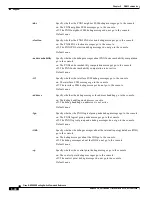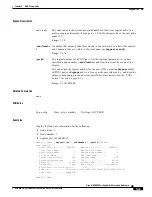
5-62
Cisco MGX 8850 Routing Switch Command Reference
Release 2.0, Part Number 78-10467-04 Rev C0, October 2001
Chapter 5
PNNI Commands
dsppnni-idb
dsppnni-idb
Display PNNI Internal Data Base
—
display the PNNI link-state information for the node.
The dsppnni-idb command applies solely to debugging. It lets you see all the nodes and links that the
current node has discovered. If a node or link should be in the internal database (IDB) but is missing,
you can check the PTSEs (dsppnni-ptse) to begin tracing the missing topology information.
An IDB stores all the logical nodes known to the local node (its own levels and the network nodes in
each logical node's view) and the outgoing links from all of them. The IDBs are the source of all address
and routing tables in the peer group. When a node advertises PNNI topology state elements (PTSEs), the
updated information goes into the IDB updates. The system address table, local network reachable
address table, background routing tables, and PNNI summary address table receive updates from the
IDB as appropriate.
The dsppnni-idb command can display all the contents or a subset of the IDB. You can specify the
granularity of the display by using the optional parameters:
•
If you enter dsppnni-idb with no parameters, the display shows the internal topology database of
all nodes in the peer group.
•
If you specify a node index, the display shows the internal topology database of all nodes that are
visible to the local, logical node with the specified index.
•
If you specify a node number, the display shows the internal topology database for a specific, remote
node within the peer group. To see the valid node numbers for nodes in the peer group, first use
dsppnni-node-list.
•
If you specify a port ID after specifying a node number, the display shows the internal topology
database of that specific port on that remote node.
Cards on Which This Command Runs
PXM45
Syntax
dsppnni-idb [node-index] [-nodeNumber node-number [-portId port-id]]
















































